Items
Tag is exactly
Spanish Flu
-
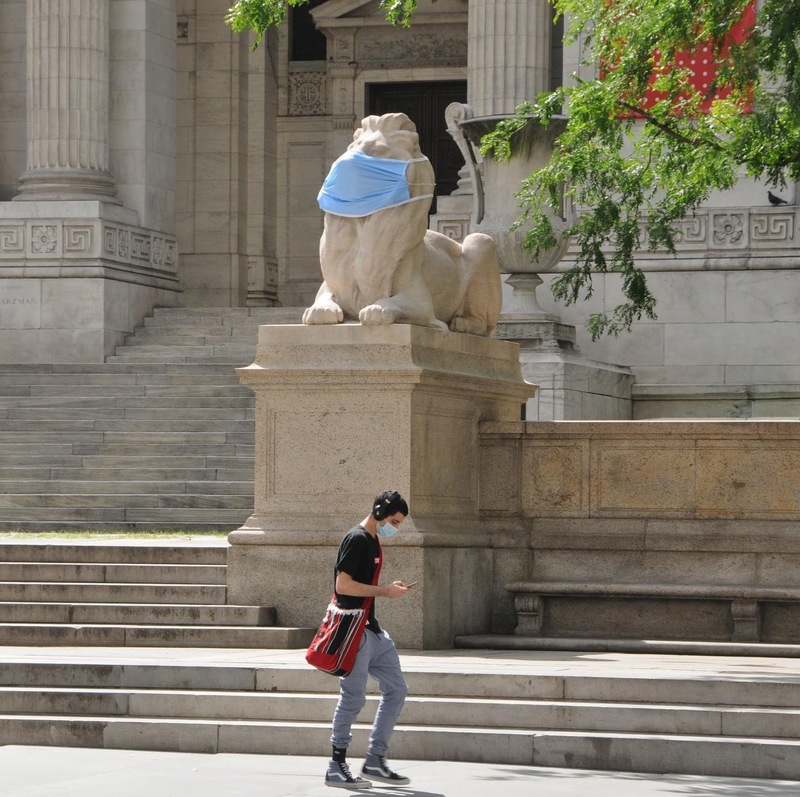 2020-07-27
2020-07-27Patience and Fortitude
The New York Public Library’s website explains, “During the 1930s, Mayor Fiorello LaGuardia named [the library lions] Patience and Fortitude for the qualities New Yorkers would need to survive the economic depression.” I remembered this fact and connected immediately with it the first time I saw Patience and Fortitude wearing their masks in solidarity with the New Yorkers they have watched over for more than a century. It struck me that we would need those virtues to make it through COVID-19 as well. “Those lion statues have seen New York struggle through and overcome many hardships from the 1917 Flu to the Great Depression to September 11th,” I thought. Things were grim in New York in 2020. We were the first to experience the horror that would eventually engulf the whole country. The infection rate was high, hospitals were full, people were dying. It was easy to despair. The masked lions were a powerful symbol of the resolve and resilience of New Yorkers and a reminder that this turmoil, too, would pass into history and the city - like the lions - would remain standing. -
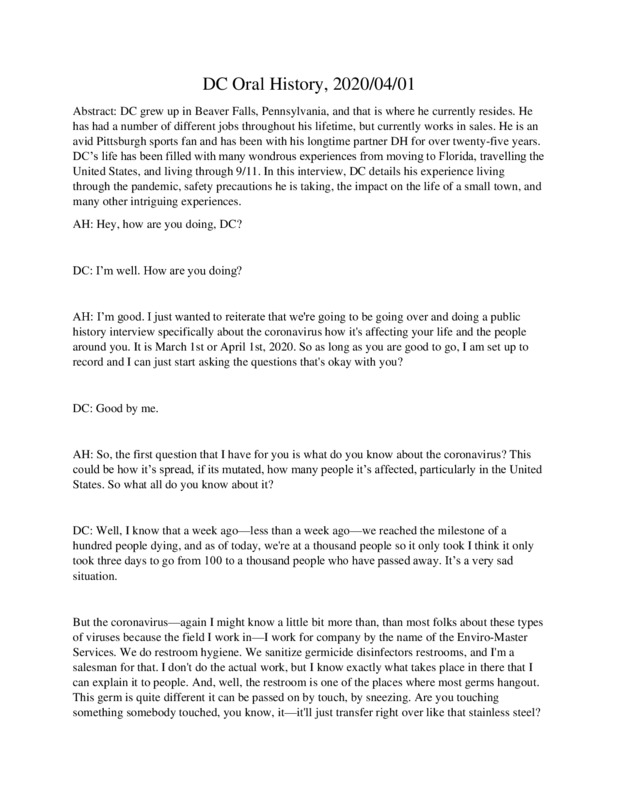 04/01/2020
04/01/2020DC Oral History, 2020/04/01
C19OH -
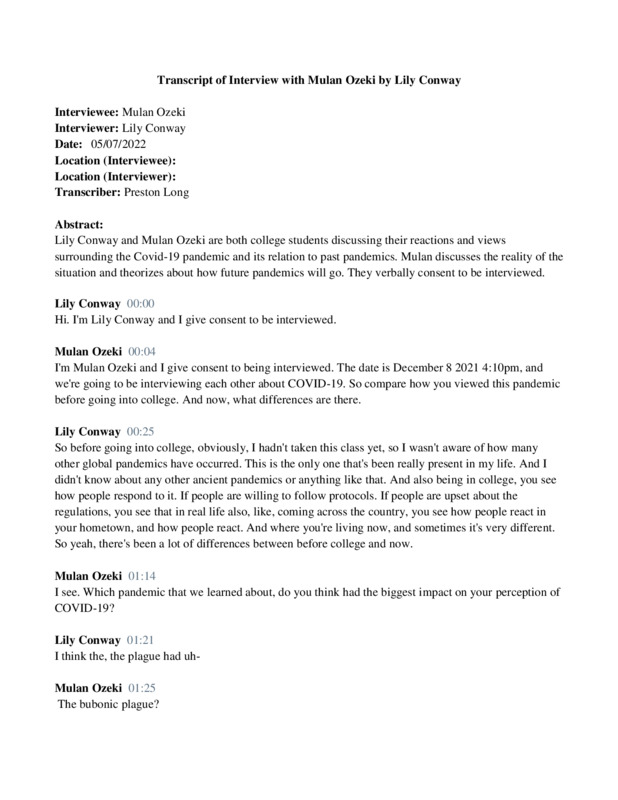 2021-12-08
2021-12-08Lily Conway and Mulan Ozeki Oral History, 2021/12/08
It says how educating yourself on the past can always provide insight on current struggles. -
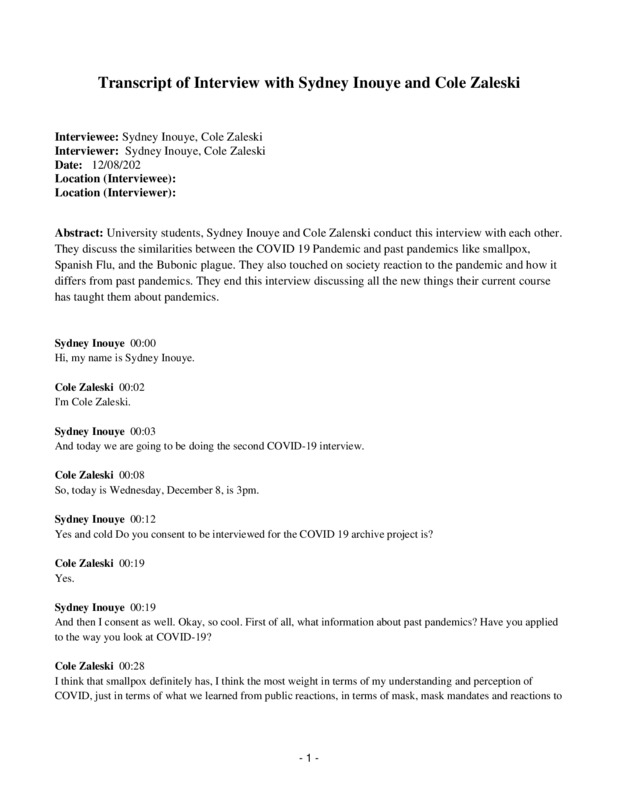 2021-12-08
2021-12-08Sydney Inouye, Cole Zaleski Oral History, 2021/12/08
We are discussing the comparisons between COVID-19 and previous pandemics, as well as how the pandemic has impacted our first year of college. -
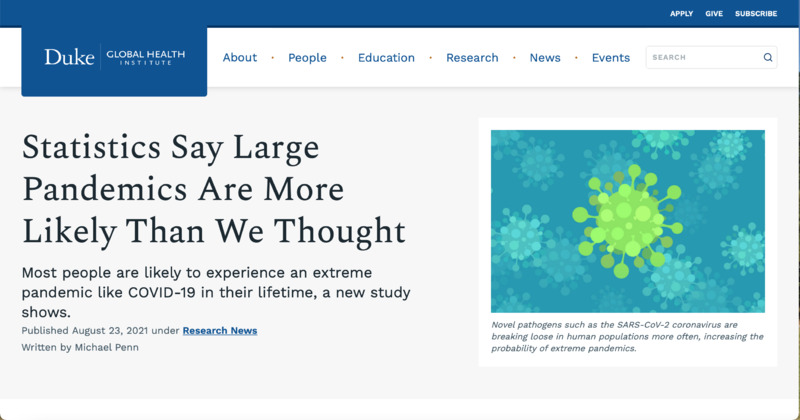 2021-08-23
2021-08-23Just when you thought it was safe...
This is an article from Duke Global Health Institute that theorizes that pandemics such as the one we are in now, are actually relatively common and most people are likely to experience one in their lifetime. -
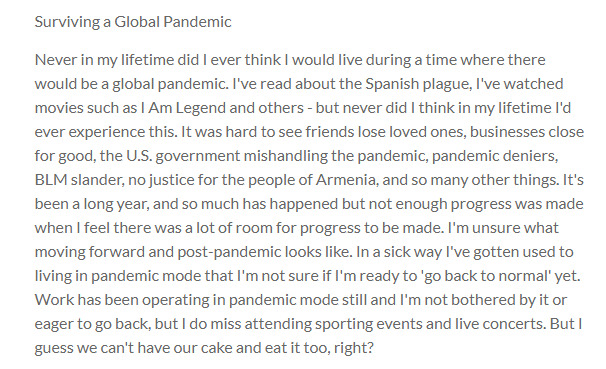 2021-04-19
2021-04-19Surviving a Global Pandemic
Never in my lifetime did I ever think I would live during a time where there would be a global pandemic. I've read about the Spanish plague, I've watched movies such as I Am Legend and others - but never did I think in my lifetime I'd ever experience this. It was hard to see friends lose loved ones, businesses close for good, the U.S. government mishandling the pandemic, pandemic deniers, BLM slander, no justice for the people of Armenia, and so many other things. It's been a long year, and so much has happened but not enough progress was made when I feel there was a lot of room for progress to be made. I'm unsure what moving forward and post-pandemic looks like. In a sick way I've gotten used to living in pandemic mode that I'm not sure if I'm ready to 'go back to normal' yet. Work has been operating in pandemic mode still and I'm not bothered by it or eager to go back, but I do miss attending sporting events and live concerts. But I guess we can't have our cake and eat it too, right? -
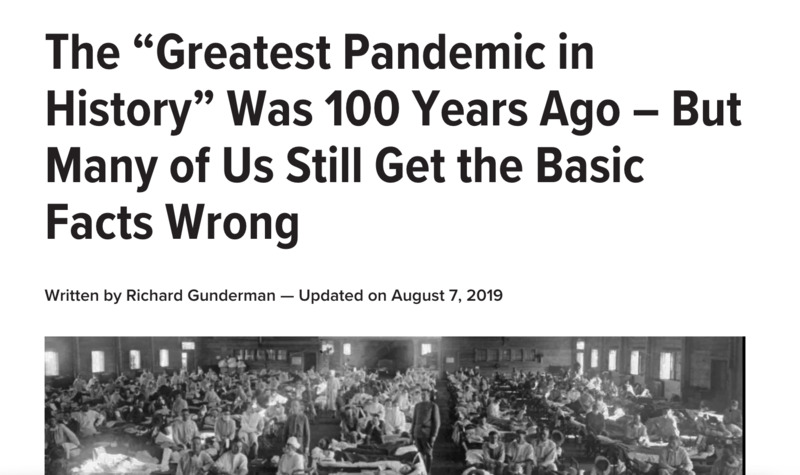 2019-08-07
2019-08-07The “Greatest Pandemic in History” Was 100 Years Ago – But Many of Us Still Get the Basic Facts Wrong
This article was published on August 7, 2019 just months before the COVID-19 pandemic hit in early 2020. The author’s intention was to share facts about the Spanish Flu so that we can be better prepared in case a similar catastrophic event occurs again. The similarities between Spanish Flu and the current pandemic cannot easily be ignored. It makes one wonder what will be said about COVID-19 100 years from now? -
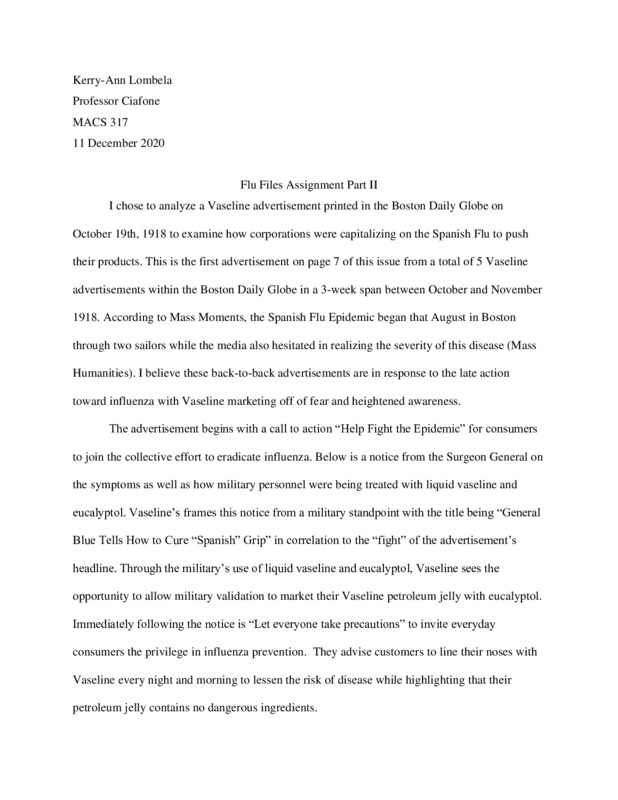 2020-12-11
2020-12-11Vaseline Advertisement from 1918 to 2020
Analyzing a Vaseline advertisement and its connection to COVID-19 -
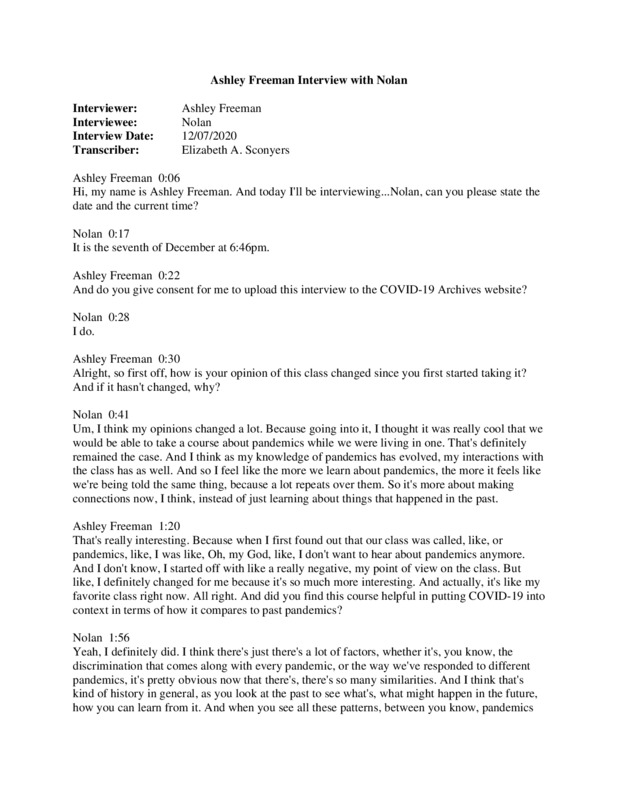 2020-12-07
2020-12-07Nolan Oral History 12/07/2021
A few questions that show how Nolan's thoughts of the pandemic have changed. -
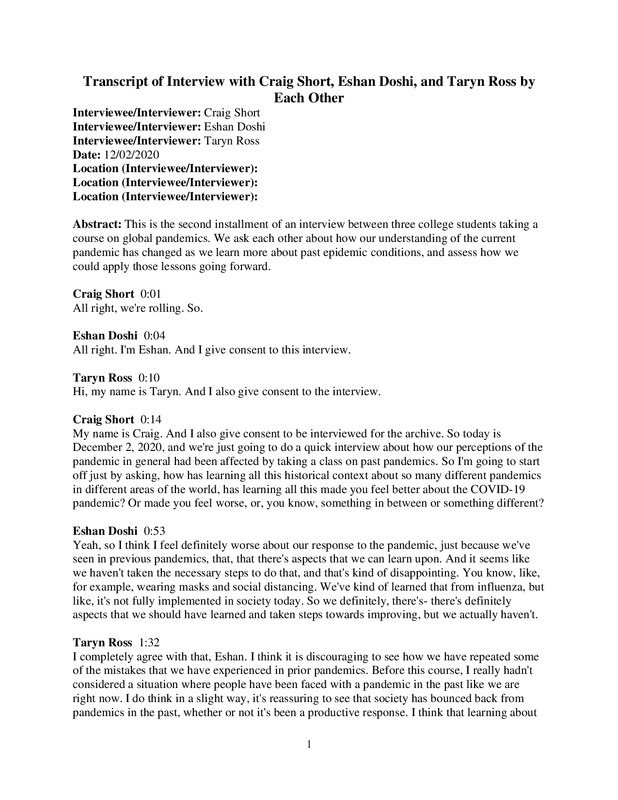 2020-12-02
2020-12-02Craig Short, Eshan Doshi, and Taryn Ross Oral History, 2020/12/02
This is the second installment of an interview between three college students taking a course on global pandemics. We ask each other about how our understanding of the current pandemic has changed as we learn more about past epidemic conditions, and assess how we could apply those lessons going forward. -
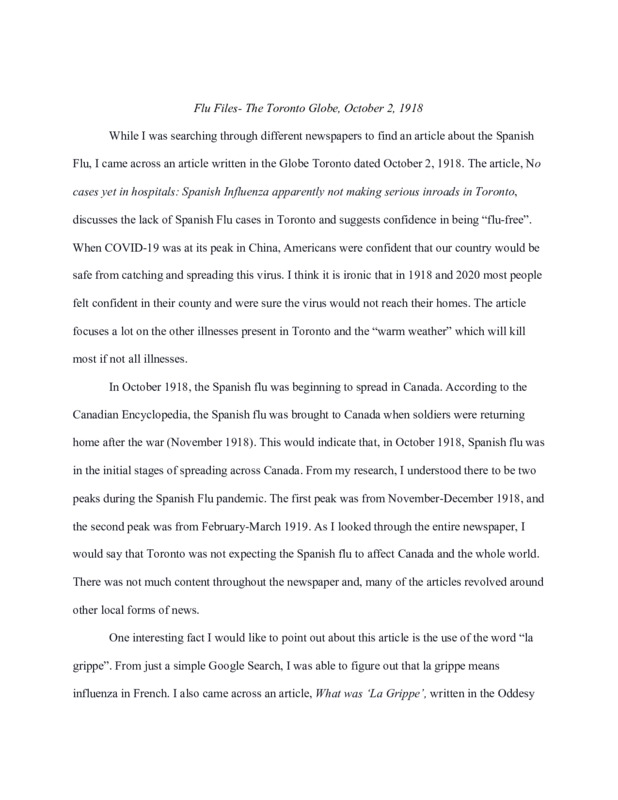 2020-11-19
2020-11-19History does repeat itself
In this short paper, I wrote about similarities between the 1918 Spanish Flu the 2020 COVID-19 pandemic. I analyze an article written in the Toronto Globe on October 2nd, 1918, and compared it to the events that happened in January-February 2020 in the United States. -
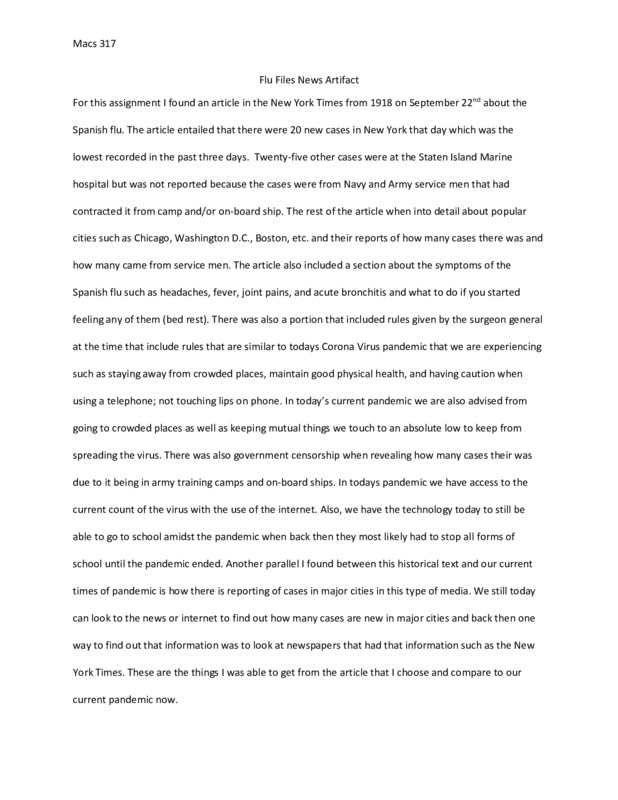 1918-09-22
1918-09-22Flu file Artifact paper
It is about the Spanish flu during 1918 and how it is similar to our current pandemic. -
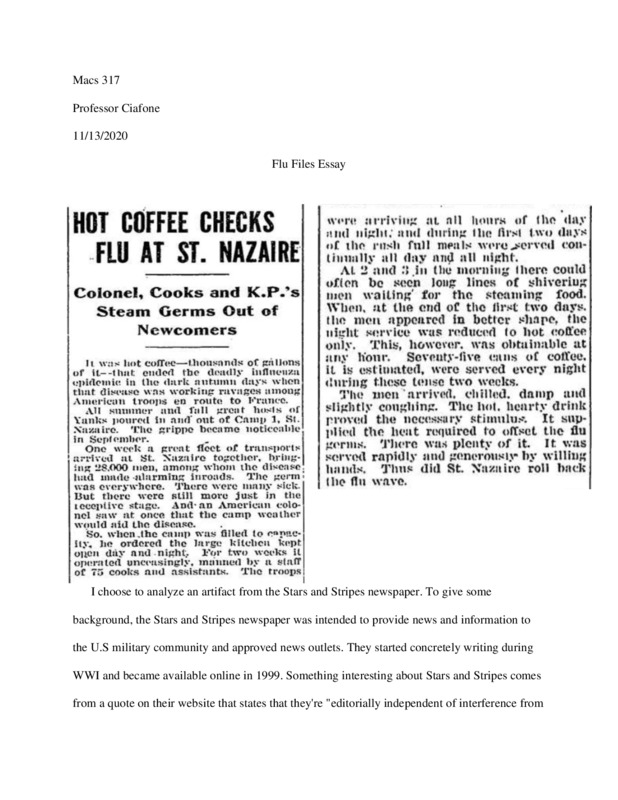 0011-11-12
0011-11-12Repeating History
I compared something that was written about the Spanish Flu in 1918 to something that was said about Covid-19 in 2020. -
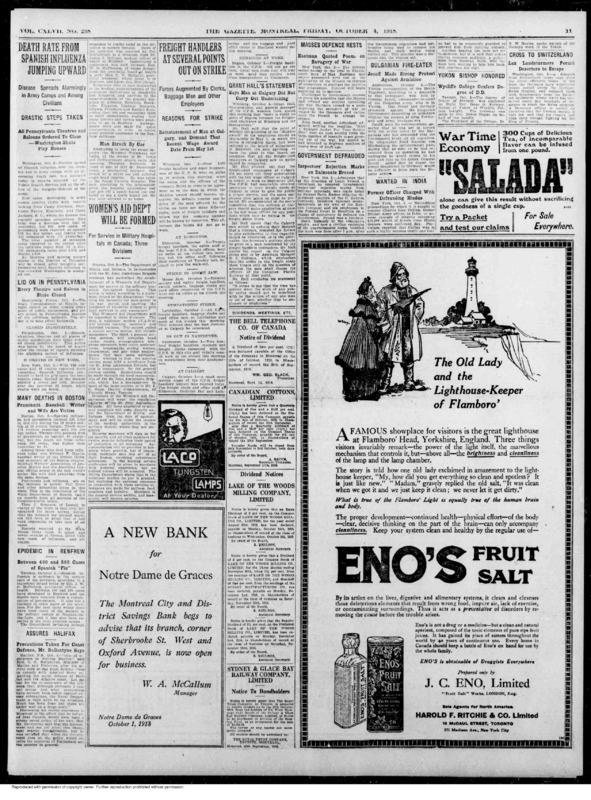 2020-11-05
2020-11-05Canada and the Pandemics
This presentation and interpretation focus on Canada during the Spanish Flu as well as COVID and how similar it is to what we are experiencing in 2020. It shows how different Canada reacted to both pandemics and what we can learn in the future. -
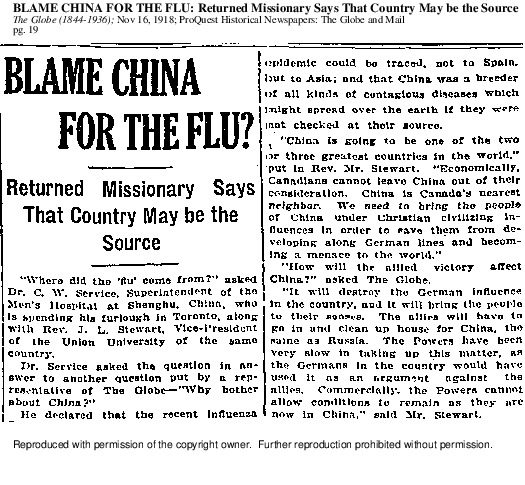 1918-11-16
1918-11-16Blame China for the Flue
In the article, the author states that the pandemic could be traced not to Spain but Asia; and that China was a breeder of all kinds of contagious diseases which might spread over the earth if they were not checked at their source. -
 2020-10-30T17:00
2020-10-30T17:00Flu Flies: October 8, 1918 how it connect to Spanish Flu and Covid-19
I feel this is important about the document I discuss about how the solider survive. Not many people focus on everyone but themselves and how to not get the COVID. But we are not aware how the solider are trying to survive similar as the Spanish Flu about the training camps. -
1919-05-19
"Flu Gets Her a Husband"
I found an article “‘Flu’ Gets Her a Husband” in the Atlanta Constitution newspaper that was published on May 19, 1919 on a page titled “In the Realm of Women’s Affairs,” which consisted of articles about women. At surface level, this article tells the story of a performer named Miss Amparito Farrar and how she found a husband. She was sick with the Spanish flu and went to see a doctor, whose name is Captain Goodrich T. Smith, for treatment. Rather than treating her, he asked for her hand in marriage. She accepted and they got married. Even though this article has a satirical and lighthearted tone, it gives a sense of how people were living life during the Spanish Flu pandemic. In reality, their love story most likely did not take off that fast, but on the other hand it is not unimaginable that they moved fast in their relationship due to the fear of dying from the Spanish flu. The writer of the article may have exaggerated the progression rate of their relationship to exemplify how fast their relationship advanced. The fear of getting the Spanish flu and dying alone was a fear many people had, so the probability of people jumping into relationships during the pandemic was high. This further reveals the mindset of individuals during the pandemic. Of course, the way Miss Farrar and Captain Smith met is one of the focal points of the article that is also informative. They met through Captain Smith’s occupancy as a doctor. This exhibits how people had to resort to unconventional ways of meeting people because the pandemic made it hard for them to socialize normally. People were more inclined to meeting people at their place of work since those were the only places they could interact with other people. In comparison to how people dealt with dating during the Spanish flu pandemic, people are utilizing social media and dating applications to meet new people because of the social distancing regulations during the Covid-19 pandemic. This has resulted in many people online dating, also known as “e-dating,” in which people develop romantic relationships with a person they met online without meeting them in person first. The article goes to show that people still have the opportunity to meet the love of their life while they may experience troubling times, whether it is during the Spanish flu pandemic or the Covid-19 pandemic. -
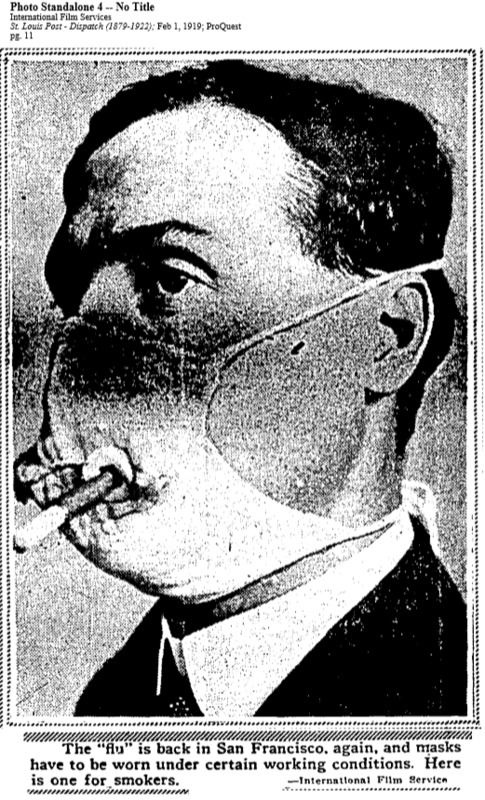 1919-02-01
1919-02-01Analysis of 1919 Image of A "Smoker's" Flu Mask
The artifact that I have chosen is a photo of a man wearing a mask, with a hole provided so that the wearer may smoke a cigarette without having to remove said mask. The photo appears in the Saint Louis Post on February 1st, 1919, and the accompanying text seems to imply that it may have been taken in San Francisco, as the city is mentioned in particular. Additionally, the descriptive text is followed with "- International Film Service", implying that the image and text originate from this organization. This would have appeared in the paper during the third wave of the Spanish flu, several months after the deadly second wave. The third wave mostly consisted of smaller scale outbreaks in larger cities, such as San Francisco and Saint Louis. The flu had already re-established itself as a major threat with the second wave, and so many cities had put laws in place to make wearing flu masks in public mandatory. These laws were disliked by many, some of whom held anti-mask gatherings and started movements to try to overturn the laws. We see similar things today, of course, as many people refuse to wear masks and defiantly hold gatherings with little to no safety precautions. This artifact raises a great deal of questions about the differing perspectives on masks and cigarettes over the course of a century. The idea of wearing a mask that accommodates cigarette smoking appears laughable today, as we now know the harm that smoking causes. Making it easier for someone to damage their lungs in the middle of a pandemic seems like a foolish idea. However, research into nicotine addiction and the harm that smoking causes was practically nonexistent in the early 1900s. Therefore, the only obvious harm that a smoker mask would cause is possible infiltration of germs and bacteria through the mask's hole. One thing I found while researching the possible source of this image is that men in particular felt uneasy with wearing masks during the Spanish flu, because they felt emasculated. Many advertisements during this time promoting mask use were framed in such a way as to hopefully soothe men's bruised egos. One could argue that there is a connection between smoker-accommodating masks and attempts to make men feel secure in their masculinity. All this said, however, there is also the possibility that this image was purely satirical. It was reproduced in the May 1919 edition of Popular Science magazine in an anti-mask joke article. The article attempts to poke holes in the rationale behind mask laws, with comments about how regulation cannot stop the transfer of disease. As I cannot find any evidence of the smoker masks being mass produced or even other photos of them, there is a good chance that the original image was made as a joke. As mentioned before, the image was sourced as coming from the International Film Service, a short-lived animation studio in the 1910s. This image could have been produced by them as part of a gag. As the version that appears in the Saint Louis Post appears to be entirely sincere, it is possible that they missed the joke and took it seriously. It is also possible that the Saint Louis Post used the image jokingly but framed it seriously, and humor has changed enough in the past century that I cannot register the dry sarcasm used in a newspaper from 1919. Overall, this artifact raises many questions and few answers. With that said, it still sparks a lot of thoughts about how people in 1919 dealt with their pandemic and how we deal with ours. -
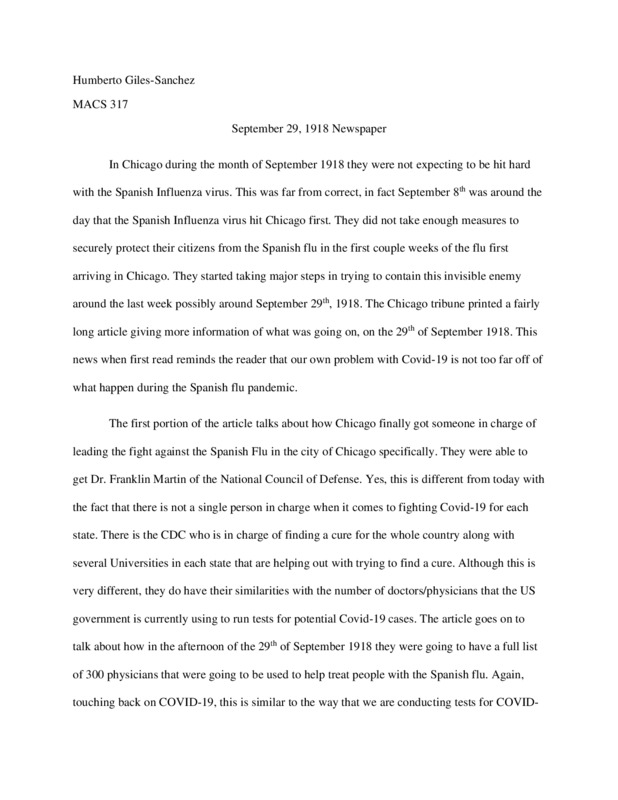 1918-09-28
1918-09-28September 29, 1918 Chicago Tribune Newspaper
The reason why I submitted this paper was to show the similarities between both the Spanish Flu and the current Covid-19 pandemic that we are going through. As philosopher George Santayana would say, "Those Who Do Not Learn History Are Doomed To Repeat It." -
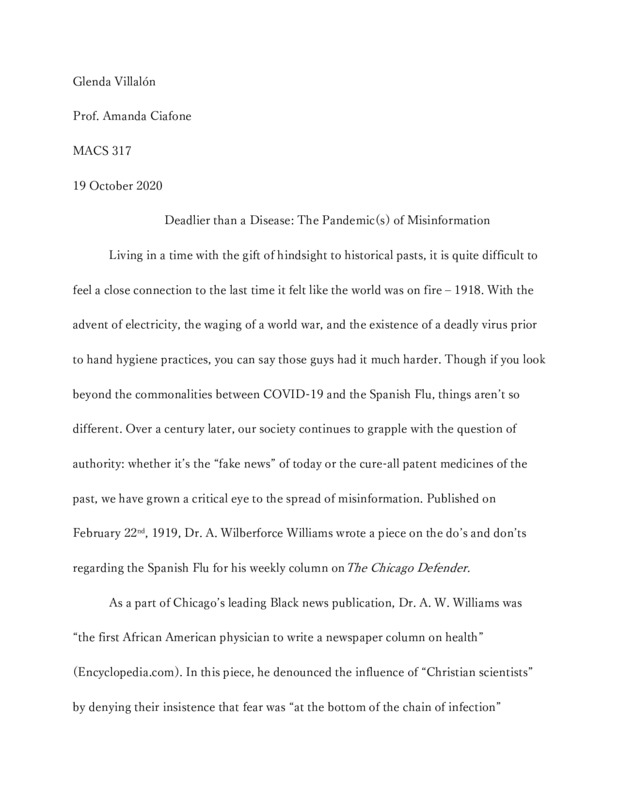 1919-02-22
1919-02-22Deadlier than a Disease: The Pandemic(s) of Misinformation
This piece brings to light the persistence in human ability to question authority. The "tar cures" of yesterday are scarily similar to the presidential suggestions to "inject bleach" today. To me, this piece brings a sense of comfort; just knowing that the people of 1918 had their share of pseudo-scientific authority figures to dodge and denounce just as we do in 2020. -
 2020-10-28
2020-10-28Twitter’s Nostradamus
This individual, The Red-Headed Libertarian, is evidently psychic, predicting that there would be a plague in 2020. Granted, their logic for guessing this is based on something that became apparent to many after COVID hit, which is that the 20th year of the past two centuries have included pandemic events. -
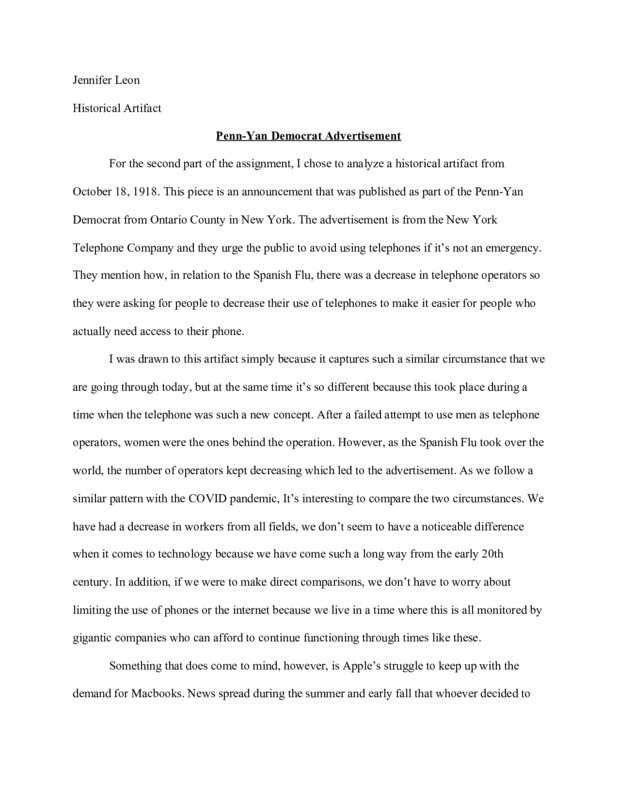 1918-10-18
1918-10-18Historical Artifact from 1918
I used the announcement from the article to create a comparison between the situation with the Spanish flu in 1918 and our current situation with the pandemic -
 1918-11-05
1918-11-05Spanish Flu Artifact
The story relates to the pandemic on the different responses of how the U.S. president addressed the Spanish Flu compared to the president of Singapore. -
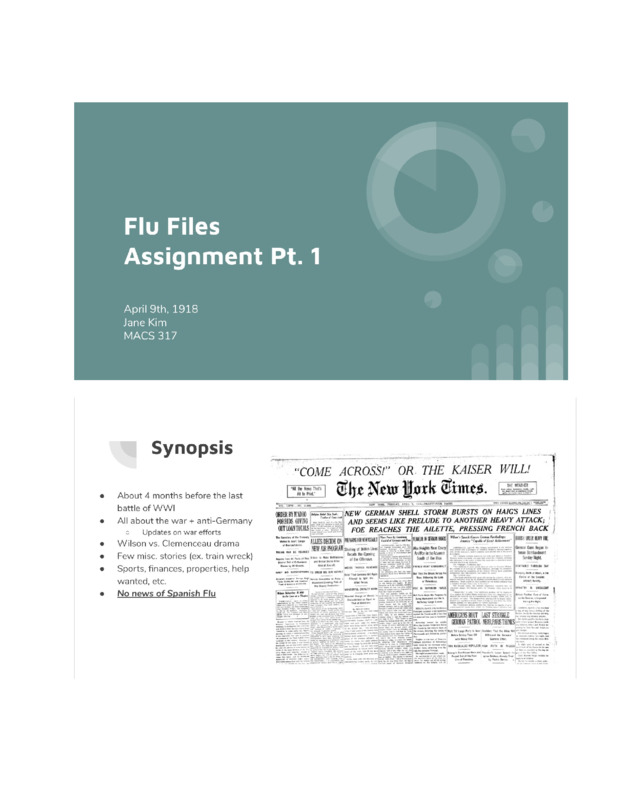 1918-11-26
1918-11-26Spanish Flu Files
For a class assignment, I had to look through historical newspapers that discuss the Spanish Flu and connect it to the current COVID-19 pandemic. -
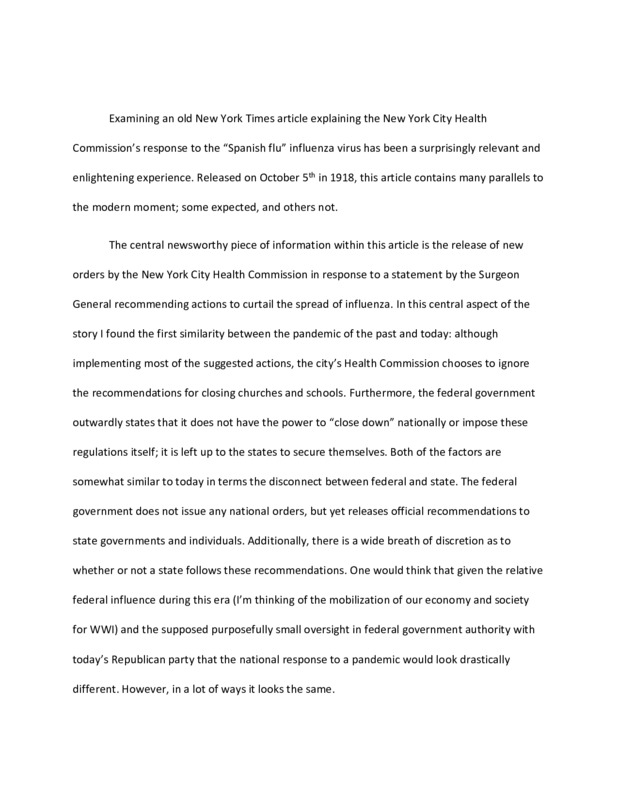 2020-10-02
2020-10-02Parallels between today and the "Spanish flu" of the 1910's
It shows that this time feels very significant in the eyes of those going through it; it made me seek out and reflect on history in an attempt to understand the current moment. -
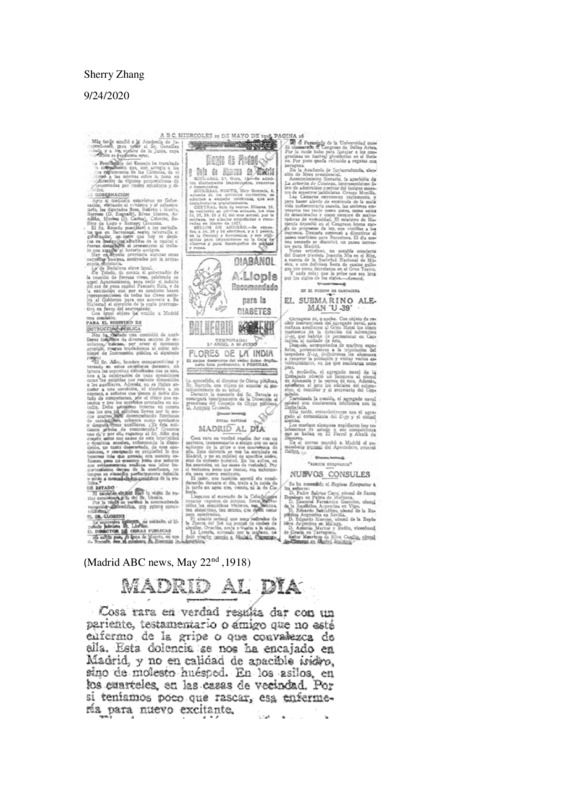 2020-09-23
2020-09-23From Spanish Flu to Coronavirus: What is the role of media?
My story explains the historical context of why Spain first referred the flu in media, and what media do to pandemic from the past to the present. -
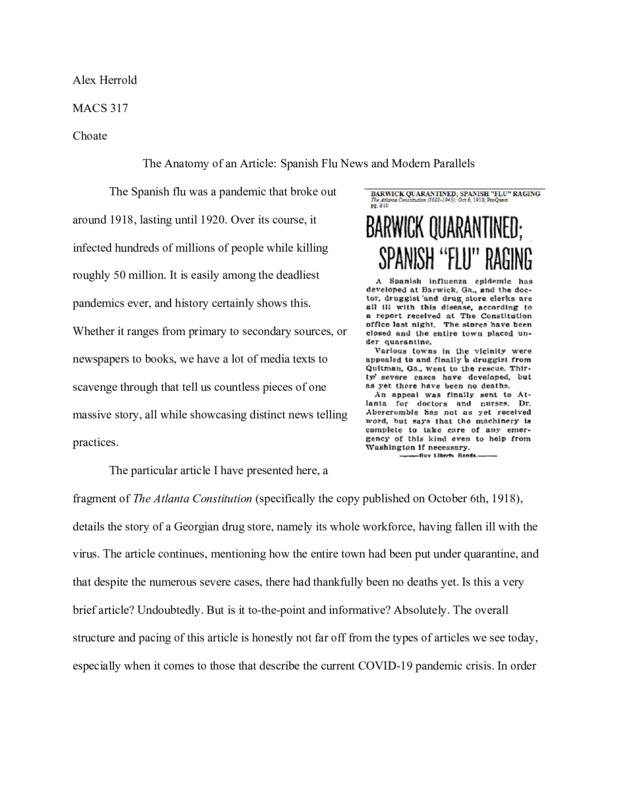 2020-08-21
2020-08-21A Brief Comparison of COVID-19 and Spanish Flu News' Composition and Purpose
While it does not delve into my personal life and experiences, it does compare two points in time and how specifically the news has approached two flu pandemics. As expected, there are some major similarities. The essay specifically analyzes the structure for a short 1918 news article written about the Spanish flu. -
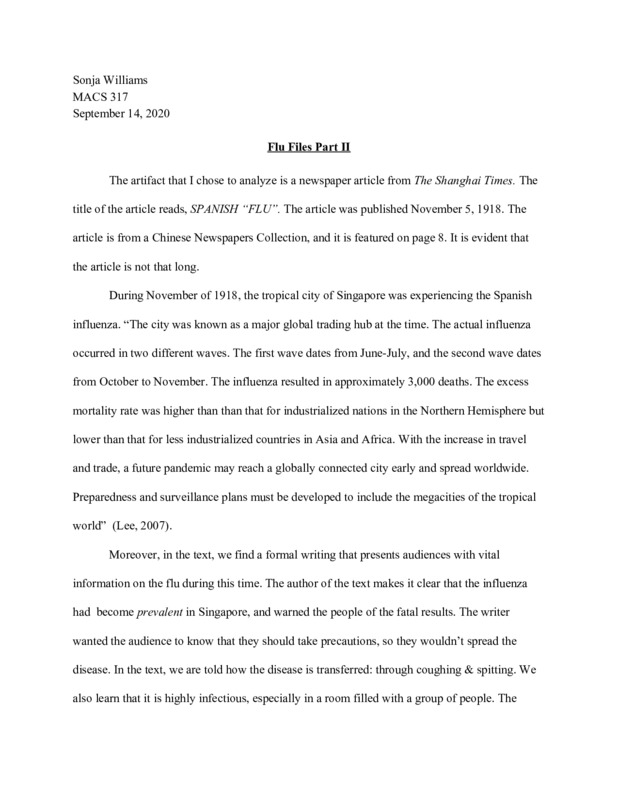 2020-09-19
2020-09-19Spanish Influenza of 1918
It says that history repeats itself, so instead of trying to prevent plagues, we should learn how to control them. -
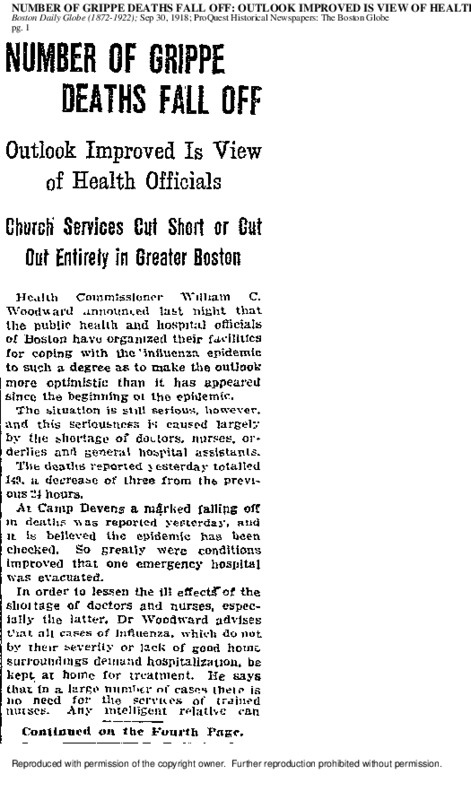 2020-09-18
2020-09-18How a Spanish flu news in 1918 may help to reflect on Covid-19 (with historical text)
History is a mirror decorated with stories. Learning about historical matierals is interesting and enlightening. An article about Spanish flu from the Boston Daily Globe on September 30th, 1918, titled Number of grippe deaths fall off and discussions with the Media History class have inspired me in understanding health policies, social changes, and more from diverse perspectives during the Covid times. -
 1918-09-17
1918-09-17The Boston Globe's Blunder
My flu files project is about this article from the Boston Globe, published on September 17th, 1918, nearly 102 years ago and just as the Spanish Flu was starting to become a serious issue in the United States. While the disease was yet to wreak the havoc that would eventually ensue, the seriousness of the flu was already well known, especially around military installations where it originated and often spread. The author’s choice to open with the disclosure of the barber at the base being infected is actually quite clever, because it shows that not only is the flu spreading rapidly, but that people in specific positions being infected is exponentially more dangerous as they will be exposed to more people (and in the case of a barber be quite close to them) giving them more opportunities to spread the flu. It is very apparent how the article tries to prevent panic by slightly underselling the seriousness of the pandemic, stating nonchalantly that “It was made known today that there are more than 3000 cases of Spanish Influenza at the base hospital now”. 3000 cases at a single military base is absolutely devastating but the article attempts to soften it in the next sentence by stating that “not all cases are serious” and “there is room at the hospital for 1500 more cases”. Even if that is true it is clear that the situation was already far from under control and obviously did not get much better from there. The article describes how the base has had to put a soft quarantine on the hospital and has repurposed an additional 12 wards of the hospital just for dealing with the flu. The section finally ends optimistically, stating that the flu has likely reached its zenith at the base. These attempts to distract or under exaggerate numbers of pandemics to prevent mass hysteria are unfortunately quite familiar to anyone who has been following more recent events, and in both cases many of them have been proven wrong. -
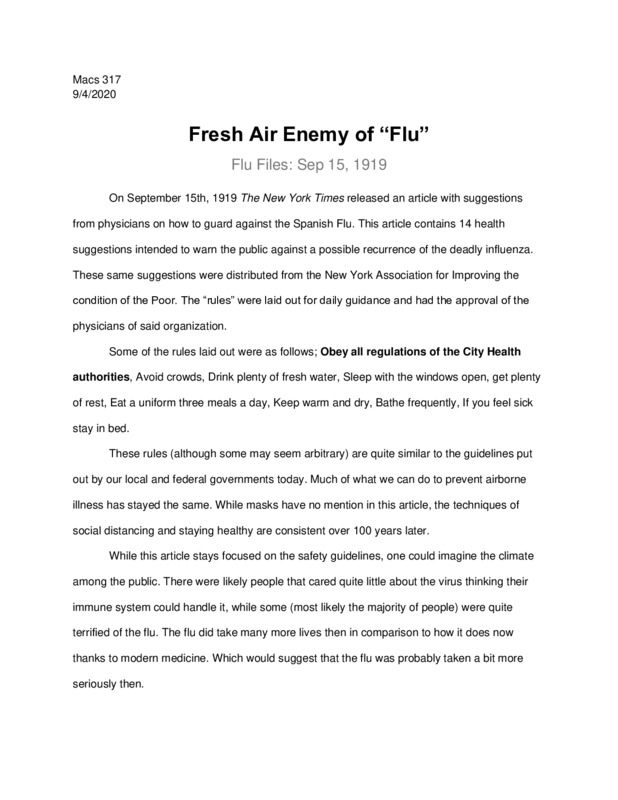 2020-09-04
2020-09-04Fresh Air Enemy of “Flu” Flu Files: Sep 15, 1919
Guidelines *Historical analysis of a newspaper article *New York Times article -
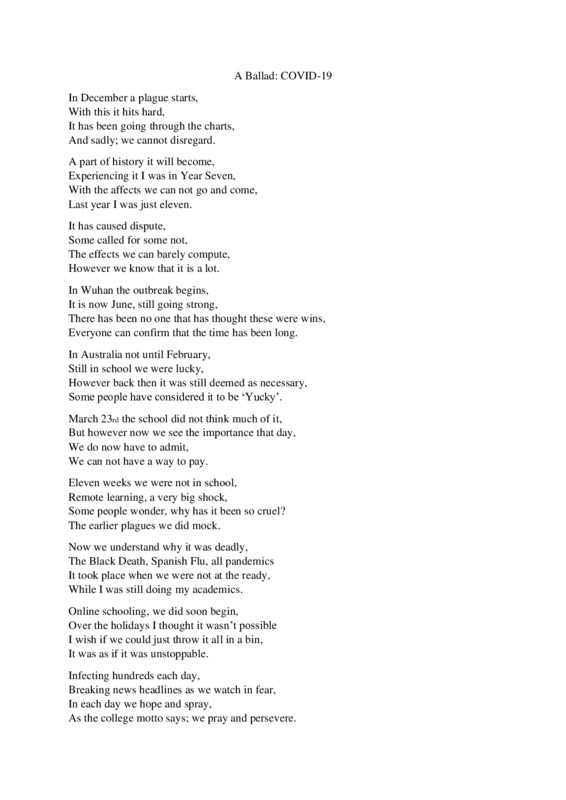 2020-06-12
2020-06-12A Ballad: COVID-19
It is a ballad about the virus itself. -
 2020-05-12
2020-05-12How history exams will be in the future
I'm taking a history class right now, that goes into detail about the Great Depression, World War, Spanish Flu etc., and how people coped with the pandemic. This meme foresees how history classes will be taught 50-100 years from now, where people will be learning everything happening right now -
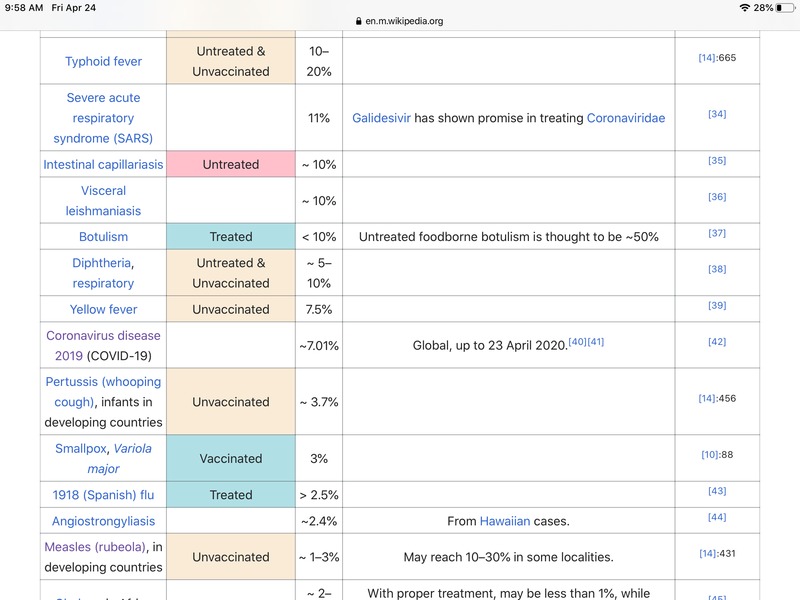 2020-04-24
2020-04-24List of human disease case fatality rates
When I first came across this Wikipedia entry in January of 2020, the death rate for COVID-19 was below that of the Spanish flu. Day by day it has been creeping inexorably up. -
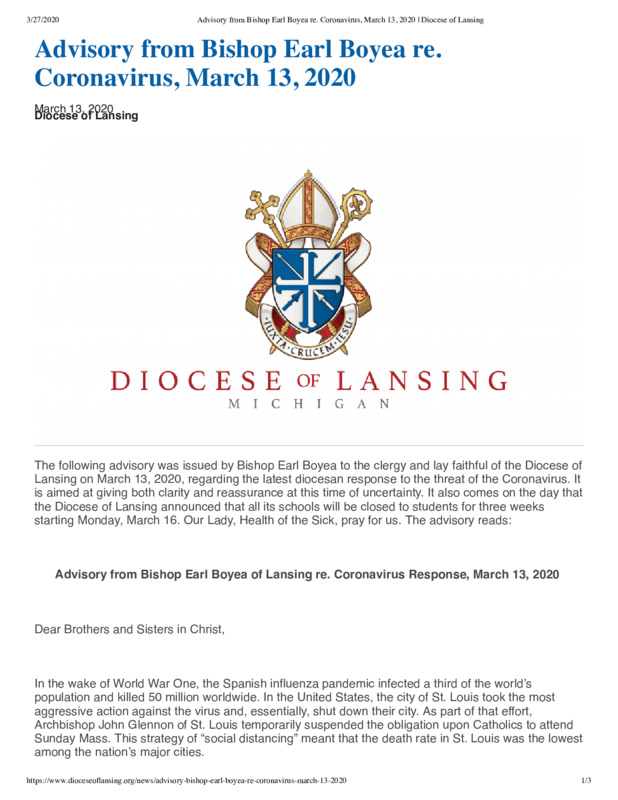 2020-03-13
2020-03-13An advisory from the Bishop of Lansing releasing Catholics from mass obligations
An advisory from the Bishop of Lansing releasing Catholics from mass obligations and reminding the congregation about how some parishes responded to the Spanish Flu seriously and that had a positive effect. "All Catholics within the Diocese of Lansing are dispensed from the grave obligation of attending Holy Mass on a Sunday. This applies to everybody and is particularly aimed at those groups most at risk from infection, including the elderly and those with compromised immune systems." #HIST5214 -
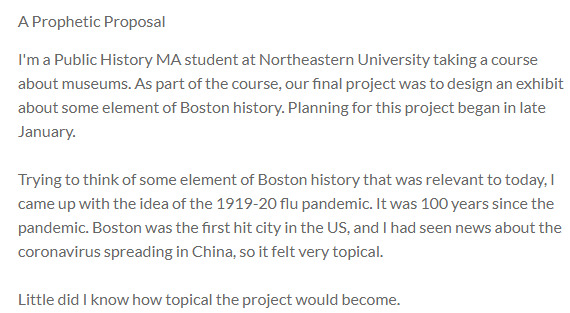 2020-01
2020-01A Prophetic Proposal
I'm a Public History MA student at Northeastern University taking a course about museums. As part of the course, our final project was to design an exhibit about some element of Boston history. Planning for this project began in late January. Trying to think of some element of Boston history that was relevant to today, I came up with the idea of the 1919-20 flu pandemic. It was 100 years since the pandemic. Boston was the first hit city in the US, and I had seen news about the coronavirus spreading in China, so it felt very topical. Little did I know how topical the project would become. -
 2020-03-20
2020-03-20Remembering pandemics
2009 Encyclopedia of Melbourne commentary on the Swine Flu, reflecting on the 1919 Spanish Flu epidemic and noting historical continuities and memory making. -
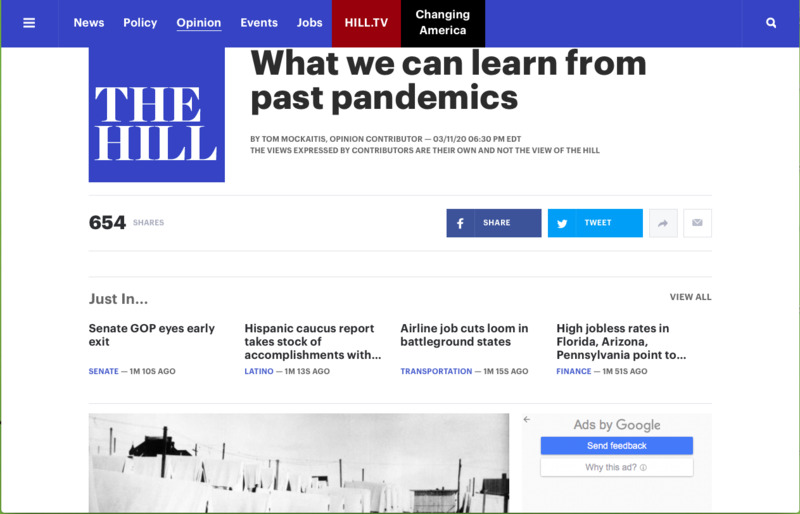 2020-03-11
2020-03-11What we can learn from past pandemics
The article provides a good overview of the history of pandemics, from the 6th through 20th centuries.
